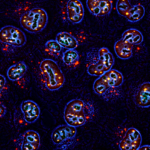Lien vers Pubmed [PMID] – 19843541
Hum. Mol. Genet. 2010 Jan;19(1):181-95
Post-translational modification by SUMO (small ubiquitin-like modifier) was proposed to modulate the pathogenesis of several neurodegenerative diseases. Spinocerebellar ataxia type 7 (SCA7) is a neurodegenerative disorder, whose pathology is caused by an expansion of a polyglutamine stretch in the protein ataxin-7 (ATXN7). Here, we identified ATXN7 as new target for SUMOylation in vitro and in vivo. The major SUMO acceptor site was mapped to lysine 257, which is part of an evolutionarily conserved consensus SUMOylation motif. SUMOylation did not influence the subcellular localization of ATXN7 nor its interaction with components of the TFTC/STAGA complex. Expansion of the polyglutamine stretch did not impair the SUMOylation of ATXN7. Furthermore, SUMO1 and SUMO2 colocalized with ATXN7 in a subset of neuronal intranuclear inclusions in the brain of SCA7 patients and SCA7 knock-in mice. In a COS-7 cellular model of SCA7, in addition to diffuse nucleoplasmic staining we identified two populations of nuclear inclusions: homogenous or non-homogenous. Non-homogenous inclusions showed significantly reduced colocalization with SUMO1 and SUMO2, but were highly enriched in Hsp70, 19S proteasome and ubiquitin. Interestingly, they were characterized by increased staining with the apoptotic marker caspase-3 and by disruption of PML nuclear bodies. Importantly, preventing the SUMOylation of expanded ATXN7 by mutating the SUMO site increased both the amount of SDS-insoluble aggregates and of caspase-3 positive non-homogenous inclusions, which act toxic to the cells. Our results demonstrate an influence of SUMOylation on the multistep aggregation process of ATXN7 and implicate a role for ATXN7 SUMOylation in SCA7 pathogenesis.

